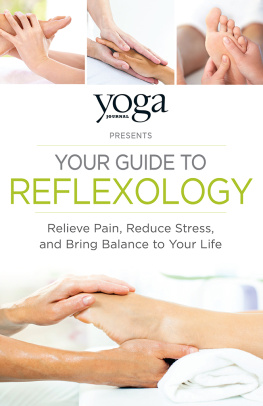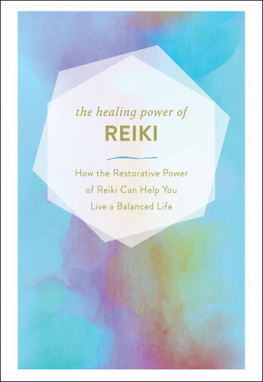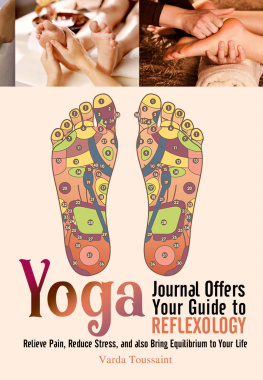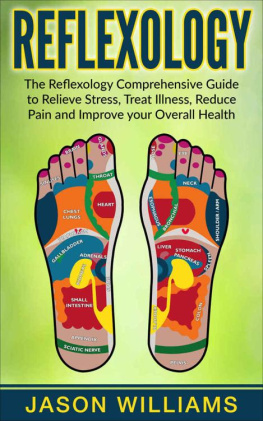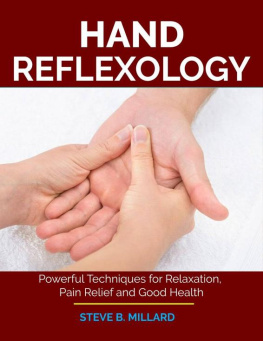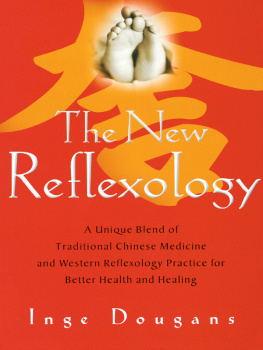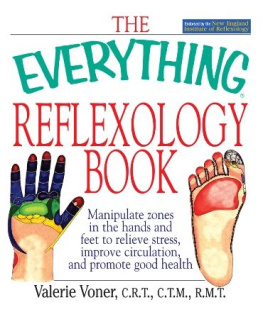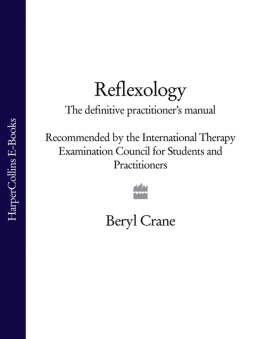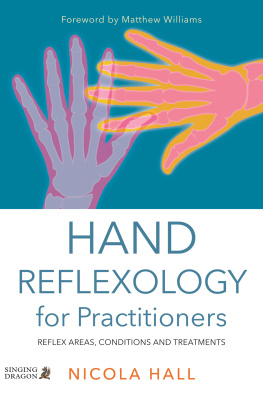Contents
Guide
yoga
JOURNAL
PRESENTS
YOUR GUIDE TO
REFLEXOLOGY
Relieve Pain, Reduce Stress, and Bring Balance to Your Life

Avon, Massachusetts
CONTENTS
INTRODUCTION
REFLEXOLOGY IS A HEALING ART. A practitioner of reflexology applies gentle pressure, using specific thumb and finger techniques, to help relieve stress from the body of the receiver. But dont mistake reflexology for a massage! This pressure is applied to points on the feet and hands that reflect other areas and parts of the body. Through reflexology you will encourage the body to relax, to let go of stress, to recognize a new way of being.
Everyone responds to stress differently. The key is, everyone responds. Reflexology teaches the body not to react to stress but, instead, to relax, letting the stress flow off rather than in.
Yoga Journal Presents Your Guide to Reflexology will help you to better understand the benefits of reflexologyand how to achieve them. Reading this book will give you tools to use to help others any time there is a need. Just think, with the gentle application of your hands you could help relieve your childs stuffy nose, your spouses headache, or even your own aches and pains.
Here are some of the most important benefits of performing reflexology:
- Helps alleviate stress and tension.
- Improves circulation throughout the body.
- Aids in the removal of toxins.
- Helps the body maintain a natural state of homeostasis.
- Encourages the immune system to work at its optimum level.
- Helps rejuvenate the system and increase energy levels.
- Breaks up the blockages that affect the flow of energy throughout the body.
- Relieves common aches and pains.
- Contributes to the overall well-being of the body, mind, and soul.
- Promotes healthy organ function.
You can use reflexology to help your family and friendsand you can even pursue it as a career. Whatever your goals, this book will help you get started.
In Yoga Journal Presents Your Guide to Reflexology, youll learn reflexology techniques and when, how, and where to perform them. Youll also learn some of the history and theory of reflexology, as well as its evolution. Youll be introduced to some basic aspects of anatomy and physiology as they specifically relate to reflexology. Youll learn how to set your intentions, how to create a holistic reflexology experience, and when not to do reflexology. defines terms commonly used in reflexology.
This book is not intended to serve as a replacement for professional training. It is, however, designed to help you decide on which path in the journey of healing you wish to travel, and to encourage you to pursue this fantastic healing art in the way that speaks to you.
Take what you learn in this book and begin your travels into the wonderful world of touch. Explore schools and wellness centers, take classes, and become inspired. Reflexology will delight you, whether youre having fun or becoming a professional. Enjoy being a giver and you will receive.
PART 1
WHAT IS REFLEXOLOGY?
Natural forces within us are the true healers of disease.
Hippocrates
In this part, youll discover what reflexology is (and isnt!). Youll take a step back to the past to look at the origins of reflexology around the world and trace its roots from the ancient Egyptian and Mayan cultures to the present day. Youll explore how the scientific revolution of the sixteenth century helped provide the intellectual framework for the practice of reflexology. And youll look at how it is currently used.
Then youll find out what reflexology can do for your bodynot just for relieving stress but for improving circulation, releasing toxins, and more. Curious about how reflexology can stimulate the bodys own healing potential? This part will show you.
Finally, youll take a tour of the human body as it relates to reflexology, looking at the structure and function of the body and how they are reflected in the feet. And dont worry, if youre unfamiliar with terms such as zones, meridians, and chakras, they are defined hereall with the intention of getting you ready to start healing!
CHAPTER 1
REFLEXOLOGY THEN AND NOW
To acquire knowledge, one must study; but to acquire wisdom, one must observe.
Marilyn vos Savant
TAKING A BRIEF TRIP through the history of reflexology is useful as an introduction to understanding complementary, integrative healing approaches (also called modalities). Humans have left records that show an ancient tie to modern reflexology. Be they oral, artistic, or written, these accounts create a connection from the deep past to the clear present. In this chapter, youll investigate those roots of reflexology, starting with ancient healing lore. Then youll explore the scientific principles involved. Next youll look at its evolution as it has grown in popularity throughout the twentieth and twenty-first centuries, up to the present day. Finally, youll discover how professionals currently use reflexology. This grounding is intended to help you understand how reflexology and its fundamental techniques came about. But before we get to that, lets talk about what reflexology is and how it works.
What Is Reflexology?
Reflexology works points on the feet (reflex points) that reflect specific areas of the body. If you imagine a body superimposed over the soles of the feet, you can begin to understand the basis of reflexology. The head is at the toes, and the rest of the body follows down the foot.
A reflexologist works with this concept, visualizing the areas that relate to the body as they are found on the feet. (In this book, we are limiting the discussion of reflexology to the feet; however, the hands are an important medium as well.)
The healing process is performed via a systematic application of pressure to reflex points using the thumbs and fingers. The technique is specificcertain thumb and finger movements are used to access the reflex points. The reflex points represent areas of the body itself, as well as organs and glands. The reflexing of these areas creates an overall feeling of euphoric relaxation.
Reflexologists work from the toes to the heels via a slow, gentle progression, reflexing the soles, the sides, and the tops of the feet. They also work points on the lower leg. As these areas are worked, the receiver begins to relax, experiencing the stress-relieving effects immediately. Often the recipient will feel a great sense of well-being flowing through the body. Perhaps the receiver has indicated a certain area of the body that is holding tension. The reflexologist will work both feet, returning to the areas mentioned by the recipient, and reflex yet again.
This modality creates a safe, trouble-free environment in which the receiver can release stress and find total relaxation. Reflexology helps teach the recipient the importance of letting go and provides the tool with which to accomplish this level of relaxation. A full session improves circulation and can create a sense of warmth. The process involved with this holistic method promotes the elimination of toxins from the body, the restoration of peace of mind, and a deep sense of wholeness.
REFLEX POINTS
Reference to the use of reflexology is found in most eras. In every class of people, in medical practice to home remedy, reflexology has held a place of importance. Practitioners of reflexology feel this is a unique form of work that can help anyone and can never cause harm if done correctly.

